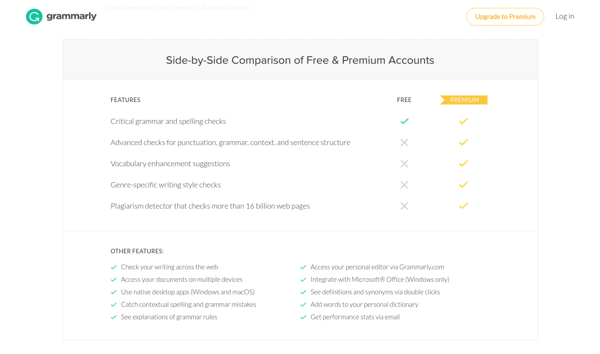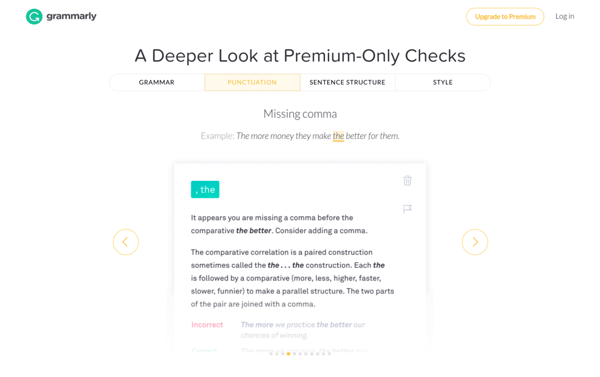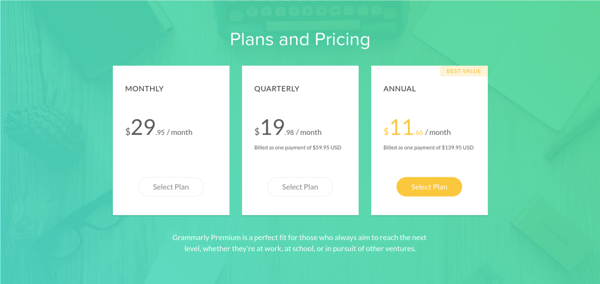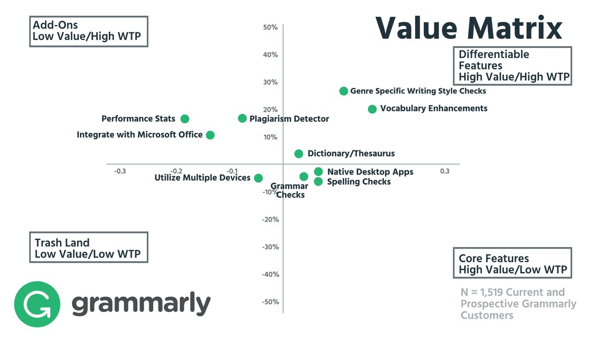Tearing down Grammarly's pricing
Patrick Campbell Jun 21 2019
First impressions last a lifetime, just like misspellings, erroneously addressed greetings, and missing commas—that's why we highly recommend using editing tools like Grammarly to check important emails before you hit "send."
Since 2008, co-founders Alex Shevchenko and Max Lytvyn have quietly grown Grammarly into a freemium product reaching millions of daily active users, many of whom pay for the extra features that come with the Premium tier. That massive growth and wide-ranging customer base bring their own set of headaches, though, with a vague pricing page and weak persona targeting holding back sales. In today's episode of Pricing Page Teardown, Peter and I check out how Grammarly can raise their pricing game and continue saving the world from bad emails.
How much does Grammarly cost?
Grammarly offers two tiers: a Free plan that includes only critical grammar and spelling checks, and a Premium plan with advanced checks and writing suggestions for $29.95 per month. Paying quarterly brings the price down to $59.95 per quarter, or $19.98 per month—a hefty discount of 33%—and an annual plan is available for $139.95 per year, or $11.66 per month, a savings of 61% over the monthly rate.
Grammarly's pricing page is confusing
With users spread across a huge range of fields, from academics to English language learners, Grammarly has their work cut out for them to create a sales page that appeals to everyone. While well-designed, the page doesn't address specific personas, focusing instead on the features and writing checks included with the product.
What isn't clear, though, is what features are available in each tier. When I first looked at their pricing page, I was a little confused about what exactly Grammarly was offering. The pricing page does include a handy feature comparison table, but the page doesn't explain, for example, how “critical” and “advanced” checks are different. There's also no way of knowing which of the “Other Features” in the list just below the table are included in the Free or Premium tiers.
 Grammarly's pricing page doesn't distinguish which features come for free and which are premium.
Grammarly's pricing page doesn't distinguish which features come for free and which are premium.
"People do that all the time, get better results, write with confidence. So, it's just one of those things where I'm a little bit like, 'Why is this different or why isn't this as obvious?"
Looking further down the page, we find a lengthy tabbed list of “Premium-Only Checks.” Grammarly once again falls back to placing the focus on features over benefits. The problem they're trying to overcome here is that the core benefit of the product—helping people communicate more effectively—is so difficult to quantify.
 Grammarly's pricing page fails to link features to benefits.
Grammarly's pricing page fails to link features to benefits.
Looking further down, the pricing table is clear—anchoring the discounted annual and quarterly plans against the monthly rate is smart, and they clearly emphasize the best value (and no doubt the highest-profit) annual plan. Once again, though, it isn't super clear what Premium users get in addition to the Free tier. It's great that Grammarly Premium helps me “level up” my writing and “reach the next level,” but won't the free version bring the same results? Tell me what I get in return for my 30 bucks a month—which, to be honest, isn't exactly cheap.
 Grammarly's pricing feels high for a B2C-style product.
Grammarly's pricing feels high for a B2C-style product.
Even after the discount, the annual plan costs $139 a year—I think that could easily be raised to $150 without losing sales. We see this “Amex effect” time and time again. Customers land on the page and see how much they could save by going with the yearly package—for Grammarly, it's over 60%—and they're more likely to whip out their credit card and pay for the full year. If people are OK with paying $139, they'll be OK paying $150—it's the $10 a year that Grammarly's missing out on for no good reason.
Grammarly could benefit from better targeting
Everyone can benefit from better writing—it doesn't matter if you're running a marketing department or earning a college degree. And while Grammarly does a decent job of casting a wide net with their positioning, they have plenty of opportunities to improve conversions by targeting specific buyer personas and feature requirements.
The data backs this up—we asked 1,519 current and prospective Grammarly users across a number of different job functions how willing they were to pay for the product.
 Grammarly customer willingness to pay based on job function.
Grammarly customer willingness to pay based on job function.
Business roles that rely on written communications, like sales and recruiting, were among the least willing to pay for improved writing. That's surprising, and it suggests a gap in positioning.
"We write a ton of email and, look, our first impression to a lot of people is via email ... First impressions last a lifetime and if this can help you present yourself a little bit better, I'm all for it." - Peter Zotto, General Manager
Jumping back to Grammarly's pricing page, it's easy to spot the disconnect. Most of the benefits listed—like how 99% of students see improved grades or how 76% of users find writing more enjoyable—just aren't relevant to business folk. There's also plenty of room for improvement by targeting other high-value job functions, like product and engineering.
Digging further into the data, it's also interesting to see which features Grammarly's charging for versus which ones are available for free. Mapping the relative value from each feature against how willing customers are to pay for that feature, the Value Matrix shows some interesting areas of opportunity.
 Grammarly willingness to pay based on relative feature value.
Grammarly willingness to pay based on relative feature value.
There's a lot that Grammarly's already hitting on the nose. Two big features in the upper-right quadrant—genre-specific writing style checks and vocabulary enhancements—are already in the Premium plan. People who like vocabulary enhancements—I'm guessing the majority of folks—are willing to spend about 20% more than the rest of the group, so making these features Premium-only is a great move.
Now over in the upper-left quadrant, the plagiarism checker could easily be turned into a paid add-on. It's a highly valuable feature—but only for a limited set of users, mostly students and other academics. By charging these users extra to unlock this feature—say, $50 a year—Grammarly could easily eke out some additional expansion revenue.
"You're playing a volume play when you have something like Grammarly."
Of course, there are two sides to every argument. While Grammarly has a huge opportunity in front of them to gain more sales, it probably isn't their highest priority right now—and for good reasons.
Grammarly shouldn't change a strategy that's working now
Taking a step back to look at Grammarly's overall acquisition strategy, their current approach to product marketing makes a lot of sense. Grammarly uses their Free tier to bring in as many free users as possible—then they offer the Premium tier to their hardcore users who rely on the service.
Grammarly is rolling freemium hard. The Free tier includes a ton of features, including the Chrome extension, Microsoft Office and Google Docs integrations, native Windows and Mac apps, and performance stats delivered via email each week. It makes sense, then, that their primary goal is to get users to sign up for a free account before upselling the most active users to the Premium tier.
For those hardcore users, springing for Premium—especially with the extra discounts for longer contracts and the frequent offers they send via email—becomes an easy decision.
Yes, Grammarly could improve their pricing page dramatically with better targeting and clearer benefits. But, given where they are in their growth trajectory, Grammarly's biggest barrier right now is awareness. How can they get more users to hear about them and try out the free service? It's not that revenue's an afterthought, but solving the awareness problem will have a much bigger impact on sales than tweaking their product page to go after a few percentage points here and there.
Grammarly's pricing model needs some work, eventually
Grammarly's in a great position. They have a huge base of freemium users, and they're dominating the market with a strong product.
Right now, Grammarly's pushing their current freemium strategy, which I think is the right move. But continuing down the path of having one big funnel for too long is a dangerous game. At some point, they'll need to switch their focus to improving how they monetize the service to keep the dollars rolling in.
From a pricing page perspective, Grammarly has done a poor job, and that's why I'm only giving them a 6.5. But with just a few small tweaks, I think they have a huge opportunity to boost sales when the time comes.
By Patrick Campbell
Founder & CEO of ProfitWell, the software for helping subscription companies with their monetization and retention strategies, as well as providing free turnkey subscription financial metrics for over 20,000 companies. Prior to ProfitWell Patrick led Strategic Initiatives for Boston-based Gemvara and was an Economist at Google and the US Intelligence community.

